温馨提示:这篇文章已超过442天没有更新,请注意相关的内容是否还可用!
摘要:本教程详细介绍了ASP.NET前后端分离技术,通过WebApi实现后端服务。前端采用Vue3、ElementPlus、Axios和Pinia等技术,全程指导开发者搭建项目框架、实现数据交互、组件开发以及状态管理。该教程内容全面,适合初学者和进阶开发者学习参考。
文章目录
- 前言
- 1、.net core 执行过程
- 2、中间件的执行过程
- 3、AOP切面编程
- Swagger
- 添加Swagger注释
- JWT
- 1、解析
- 2、配置JWT
- 配置SqlSugar
- 0、引入`SqlSugarCore`包
- 1、编写`Context`类
- 2、配置实体类
- 3、创建`Service`服务类进行数据库的CRUD
- 4、配置Controller进行路由
- 依赖注入与IOC
- IOC
- 依赖注入DI
- Autofac轻量容器的使用
- 使用Autofac完成AOP日志
- Webapi的操作返回值和方法参数
- 返回值ActionResult
- 操作方法的参数
- URL
- QueryString
- 请求报文体
- 总结
- VUE项目结构
- 主要文件
- 项目运行流程
- 添加Element-ui、AXIOS
- Axios与pinia
- AXIOS
- 使用npm等包管理工具下载axios
- 创建axios实例、封装get、post请求方法
- 封装api接口调用方法
- 在页面中调用api
- pinia使用
- 使用npm下载pinia
- 创建Store文件进行状态存储
- 在页面组件中实例化状态并赋值
前言
1、.net core 执行过程

2、中间件的执行过程
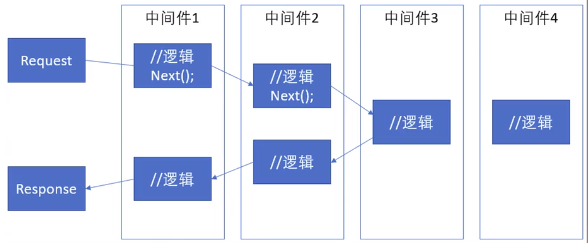
3、AOP切面编程
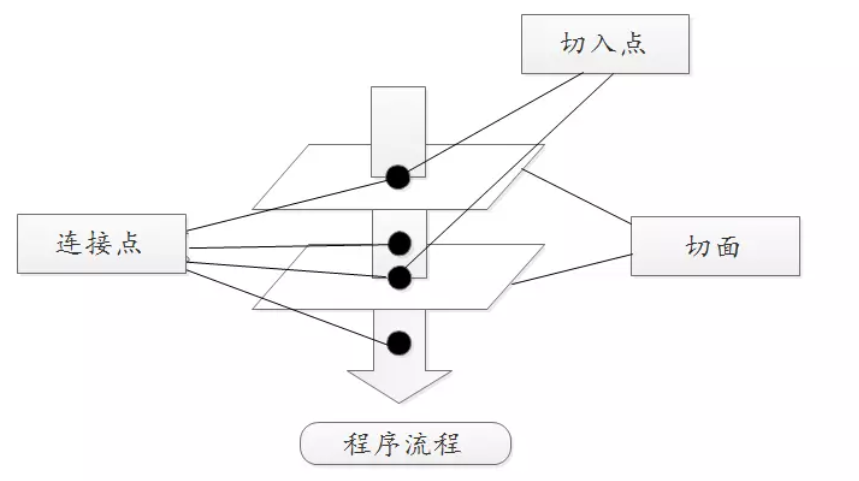
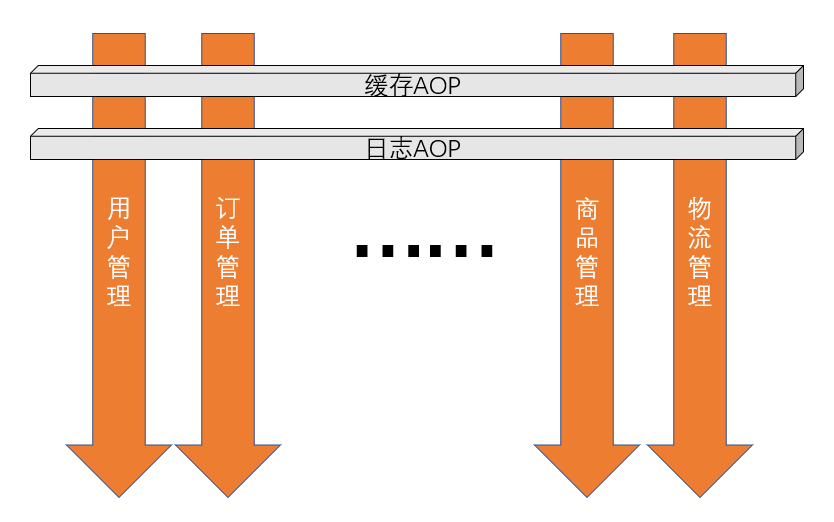
Swagger
添加Swagger注释
1、右击项目->选择属性->点击生成->输出,选中文档文件
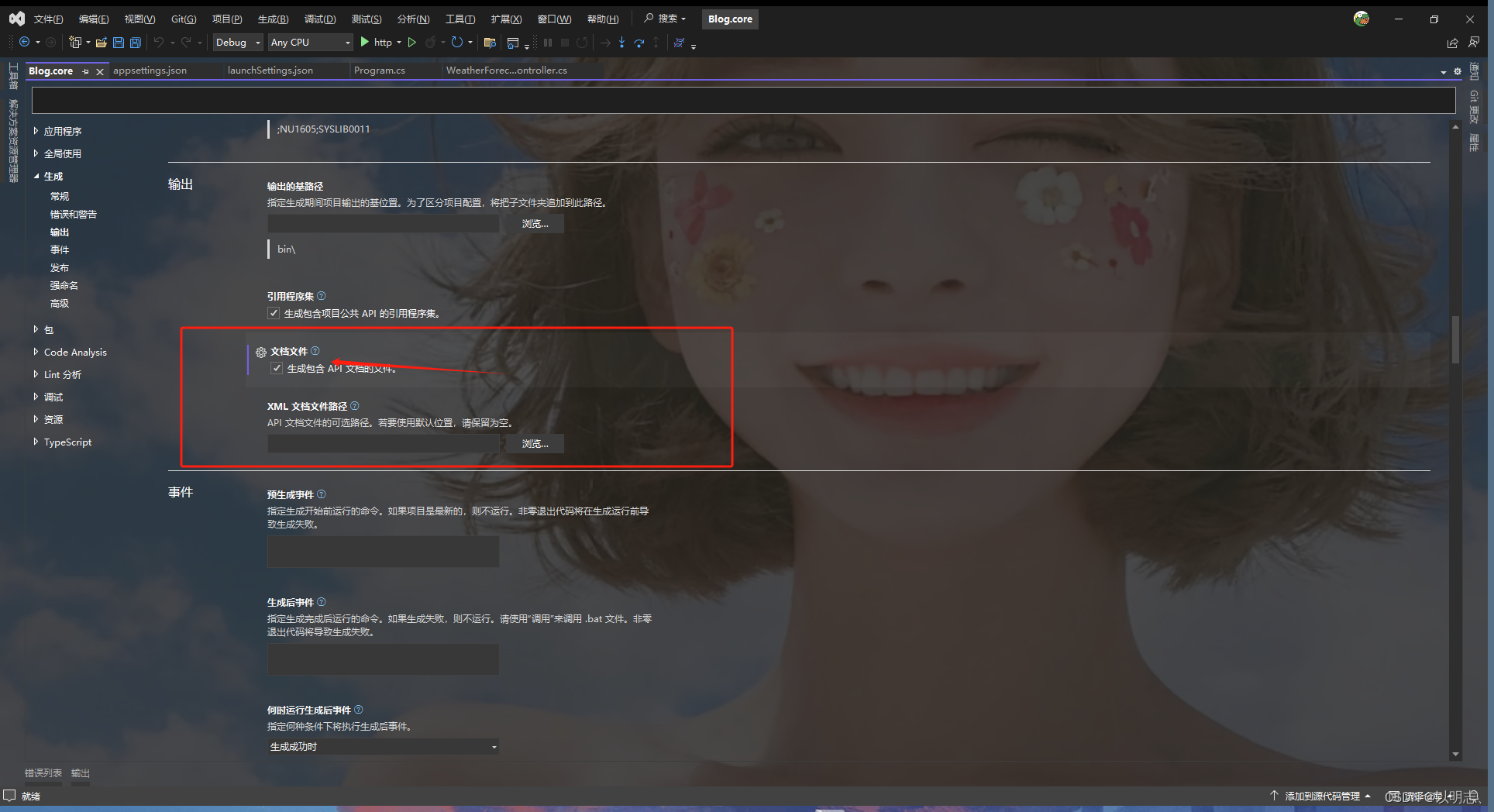
2、配置服务
在program.cs 文件里配置SwaggerUI
//增加项一 builder.Services.AddSwaggerGen(c=> { c.SwaggerDoc("v1", new OpenApiInfo { Title = "Web API", Version = "v1" }); var xmlFile = $"{Assembly.GetEntryAssembly().GetName().Name}.xml"; var xmlPath = Path.Combine(AppContext.BaseDirectory, xmlFile); c.IncludeXmlComments(xmlPath); }); //增加项二 if (app.Environment.IsDevelopment()) { app.UseSwagger(); app.UseSwaggerUI(c => { c.SwaggerEndpoint("/swagger/v1/swagger.json", "My API V1"); }); }3、在控制器的方法上加上注释即可在swagger网页上看到注释
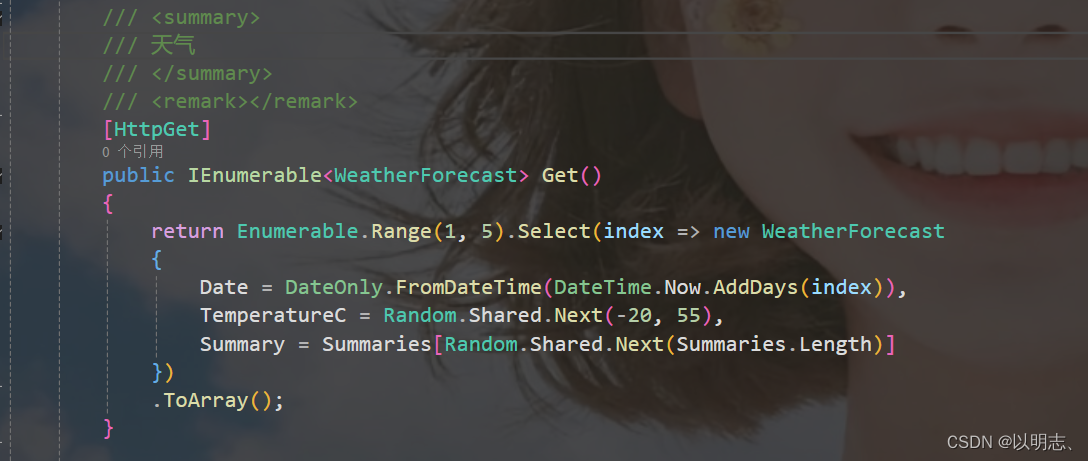
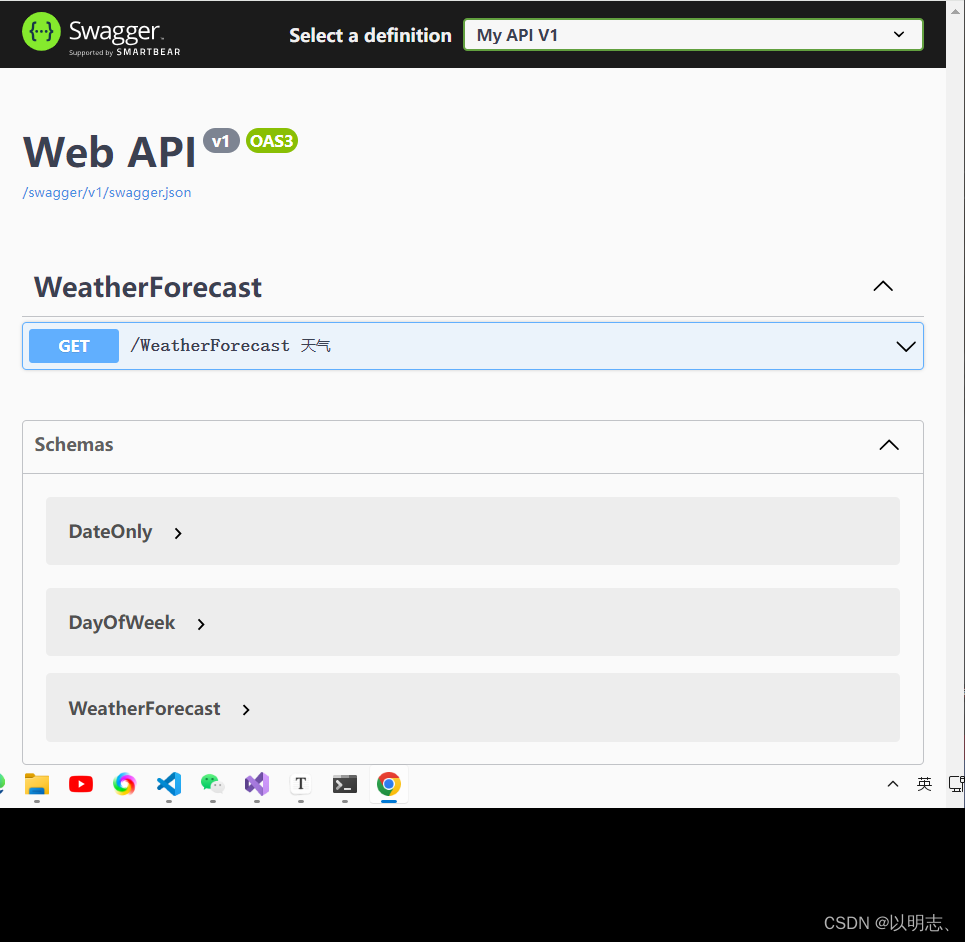
4、添加实体类的Swagger注释
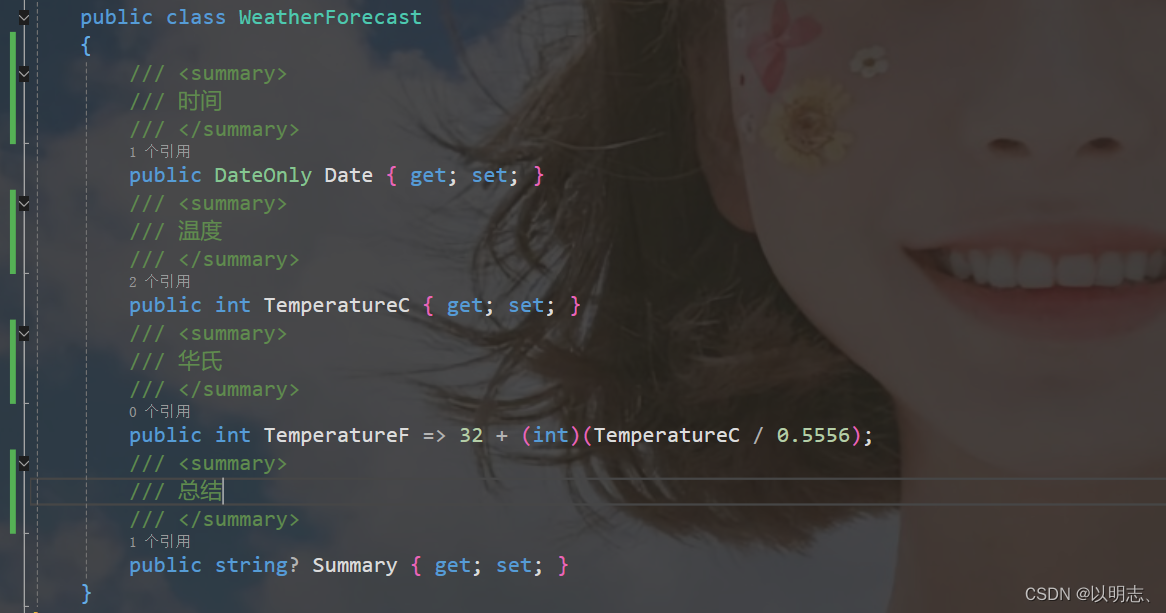

JWT
1、解析
1)客户端向授权服务系统发起请求,申请获取“令牌”。
2)授权服务根据用户身份,生成一张专属“令牌”,并将该“令牌”以JWT规范返回给客户端
3)客户端将获取到的“令牌”放到http请求的headers中后,向主服务系统发起请求。主服务系统收到请求后会从headers中获取“令牌”,并从“令牌”中解析出该用户的身份权限,然后做出相应的处理(同意或拒绝返回资源)
2、配置JWT
1、添加NuGet包Microsoft.AspNetCore.Authentication.JwtBearer
2、在appsettings.json中添加JWT配置节点
"JWT": { "SecKey": "Jamin1127!#@$%@%^^&*(~Czmjklneafguvioszb%yuv&*6WVDf5dw#5dfw6f5w6faW%FW^f5wa65f^AWf56", //密钥 "Issuer": "Jamin", //发行者 "ExpireSeconds": 7200 //过期时间 }3、在Program类里进行服务注册
#region JWT服务 // 注册JWT服务 builder.Services.AddSingleton(new JwtHelper(builder.Configuration)); builder.Services.AddAuthentication( JwtBearerDefaults.AuthenticationScheme).AddJwtBearer(options => { options.TokenValidationParameters = new TokenValidationParameters() { ValidateIssuer = true, //是否验证Issuer ValidIssuer = builder.Configuration["Jwt:Issuer"], //发行人Issuer ValidateAudience = false, //是否验证Audience ValidateIssuerSigningKey = true, //是否验证SecurityKey IssuerSigningKey = new SymmetricSecurityKey(Encoding.UTF8.GetBytes(builder.Configuration["Jwt:SecKey"])), //SecurityKey ValidateLifetime = true, //是否验证失效时间 ClockSkew = TimeSpan.FromSeconds(30), //过期时间容错值,解决服务器端时间不同步问题(秒) RequireExpirationTime = true, }; } ); builder.Services.AddAuthorization(options => { /*** "Client" 策略要求用户必须拥有 "Client" 角色才能访问相关资源。 "Admin" 策略要求用户必须拥有 "Admin" 角色才能访问相关资源。 "SystemOrAdmin" 策略要求用户必须拥有 "Admin" 或者 "System" 角色之一才能访问相关资源。***/ options.AddPolicy("Client", policy => policy.RequireRole("Client").Build()); options.AddPolicy("Admin", policy => policy.RequireRole("Admin").Build()); options.AddPolicy("SystemOrAdmin", policy => policy.RequireRole("Admin", "System")); }); #endregion //swagger里添加JWT授权 builder.Services.AddSwaggerGen(c=> { c.SwaggerDoc("v1", new OpenApiInfo { Title = "Web API", Version = "v1" }); //开启注释 var xmlFile = $"{Assembly.GetEntryAssembly().GetName().Name}.xml"; var xmlPath = Path.Combine(AppContext.BaseDirectory, xmlFile); c.IncludeXmlComments(xmlPath, true); // 配置 JWT Bearer 授权 c.AddSecurityDefinition("Bearer", new OpenApiSecurityScheme { Description = "JWT Authorization header using the Bearer scheme", Name = "Authorization", In = ParameterLocation.Header, Type = SecuritySchemeType.Http, Scheme = "bearer" }); var securityScheme = new OpenApiSecurityScheme { Reference = new OpenApiReference { Type = ReferenceType.SecurityScheme, Id = "Bearer" } }; var securityRequirement = new OpenApiSecurityRequirement { { securityScheme, new string[] { } } }; c.AddSecurityRequirement(securityRequirement); }); //启用验证中间件 app.UseAuthentication(); app.UseAuthorization();4、创建JWT类进行Token配置
using Microsoft.IdentityModel.Tokens; using System.Diagnostics; using System.IdentityModel.Tokens.Jwt; using System.Security.Claims; using System.Text; namespace Blog.core.Common.Auth { /// /// 授权JWT类 /// public class JwtHelper { private readonly IConfiguration _configuration; /// /// Token配置 /// /// public JwtHelper(IConfiguration configuration) { _configuration = configuration; } /// /// 创建Token 这里面可以保存自己想要的信息 /// /// /// /// public string CreateToken(string username, string mobile) { try { // 1. 定义需要使用到的Claims var claims = new[] { new Claim("username", username), new Claim("mobile", mobile), /* 可以保存自己想要信息,传参进来即可 new Claim("sex", "sex"), new Claim("limit", "limit"), new Claim("head_url", "xxxxx") */ }; // 2. 从 appsettings.json 中读取SecretKey var secretKey = new SymmetricSecurityKey(Encoding.UTF8.GetBytes(_configuration["Jwt:SecKey"])); // 3. 选择加密算法 var algorithm = SecurityAlgorithms.HmacSha256; // 4. 生成Credentials var signingCredentials = new SigningCredentials(secretKey, algorithm); // 5. 根据以上,生成token var jwtSecurityToken = new JwtSecurityToken( _configuration["Jwt:Issuer"], //Issuer _configuration["Jwt:ExpireSeconds"], //ExpireSeconds claims, //Claims, DateTime.Now, //notBefore DateTime.Now.AddSeconds(30), //expires signingCredentials //Credentials ); // 6. 将token变为string var token = new JwtSecurityTokenHandler().WriteToken(jwtSecurityToken); return token; } catch (Exception) { throw; } } /// /// 获取信息 /// /// /// public static string ReaderToken(string jwt) { var str = string.Empty; try { //获取Token的三种方式 //第一种直接用JwtSecurityTokenHandler提供的read方法 var jwtHander = new JwtSecurityTokenHandler(); JwtSecurityToken jwtSecurityToken = jwtHander.ReadJwtToken(jwt); str = jwtSecurityToken.ToString(); } catch (Exception ex) { Debug.WriteLine(ex.Message); } return str; } /// /// 解密jwt /// /// /// public string JwtDecrypt(string jwt) { StringBuilder sb = new StringBuilder(); try { JwtSecurityTokenHandler tokenHandler = new(); TokenValidationParameters valParam = new(); var securityKey = new SymmetricSecurityKey(Encoding.UTF8.GetBytes(_configuration["Jwt:SecKey"])); valParam.IssuerSigningKey = securityKey; valParam.ValidateIssuer = false; valParam.ValidateAudience = false; //解密 ClaimsPrincipal claimsPrincipal = tokenHandler.ValidateToken(jwt, valParam, out SecurityToken secToken); foreach (var claim in claimsPrincipal.Claims) { sb.Append($"{claim.Type}={claim.Value}"); } } catch (Exception ex) { Debug.WriteLine(ex.Message); } return sb.ToString(); } } }5、创建用户实体,进行用户密码的接收
using System.ComponentModel.DataAnnotations; namespace Blog.core.Models { public class UserInfo { /// /// 其中 [Required] 表示非空判断,其他自己研究百度 /// [Required] public string UserName { get; set; } [Required] public string Password { get; set; } [Required] public string PhoneNumber { get; set; } } }6、创建控制器,进行JWT的APi调用
using Blog.core.Common.Auth; using Blog.core.Models; using Microsoft.AspNetCore.Authorization; using Microsoft.AspNetCore.Mvc; namespace Blog.core.Controllers { [Route("[controller]/[action]")] [ApiController] public class UserController : ControllerBase { private readonly JwtHelper _jwt; /// /// 初始化 /// /// public UserController(JwtHelper jwtHelper) { _jwt = jwtHelper; } /// /// 获取Token /// /// [HttpPost] public IActionResult GetToken(UserInfo user) { //参数验证等等.... if (string.IsNullOrEmpty(user.UserName)) { return Ok("参数异常!"); } //这里可以连接mysql数据库做账号密码验证 //这里可以做Redis缓存验证等等 //这里获取Token,当然,这里也可以选择传结构体过去 var token = _jwt.CreateToken(user.UserName, user.PhoneNumber); //解密后的Token var PWToken = _jwt.JwtDecrypt( token); return Ok(token+"解密后:"+PWToken); } /// /// 获取自己的详细信息,其中 [Authorize] 就表示要带Token才行 /// /// [HttpPost] [Authorize] public IActionResult GetSelfInfo() { //执行到这里,就表示已经验证授权通过了 /* * 这里返回个人信息有两种方式 * 第一种:从Header中的Token信息反向解析出用户账号,再从数据库中查找返回 * 第二种:从Header中的Token信息反向解析出用户账号信息直接返回,当然,在前面创建 Token时,要保存进使用到的Claims中。 */ return Ok("授权通过了!"); } } }7、用来验证权限的控制器
using Microsoft.AspNetCore.Authorization; using Microsoft.AspNetCore.Mvc; namespace Blog.core.Controllers { [ApiController] [Route("[controller]")] [Authorize(Roles ="Admin")] [Authorize(Roles ="User")]//增加权限验证 public class WeatherForecastController : ControllerBase { private static readonly string[] Summaries = new[] { "Freezing", "Bracing", "Chilly", "Cool", "Mild", "Warm", "Balmy", "Hot", "Sweltering", "Scorching" }; private readonly ILogger _logger; public WeatherForecastController(ILogger logger) { _logger = logger; } /// /// 天气 /// /// [HttpGet] public IEnumerable Get() { return Enumerable.Range(1, 5).Select(index => new WeatherForecast { Date = DateOnly.FromDateTime(DateTime.Now.AddDays(index)), TemperatureC = Random.Shared.Next(-20, 55), Summary = Summaries[Random.Shared.Next(Summaries.Length)] }) .ToArray(); } } }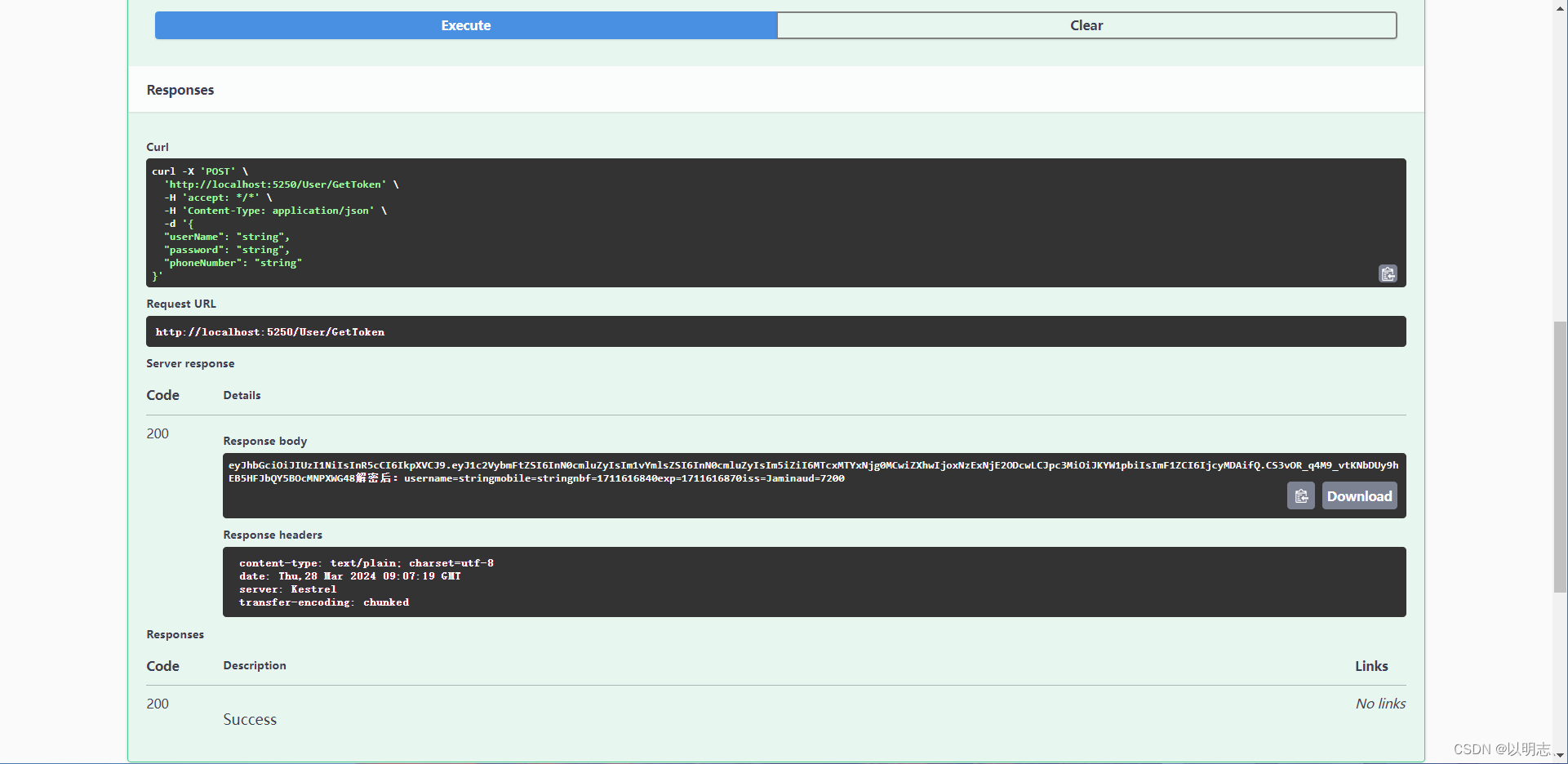
**注:获取Token后在Swagger上输入token的value就可以进行接口的调用了 **
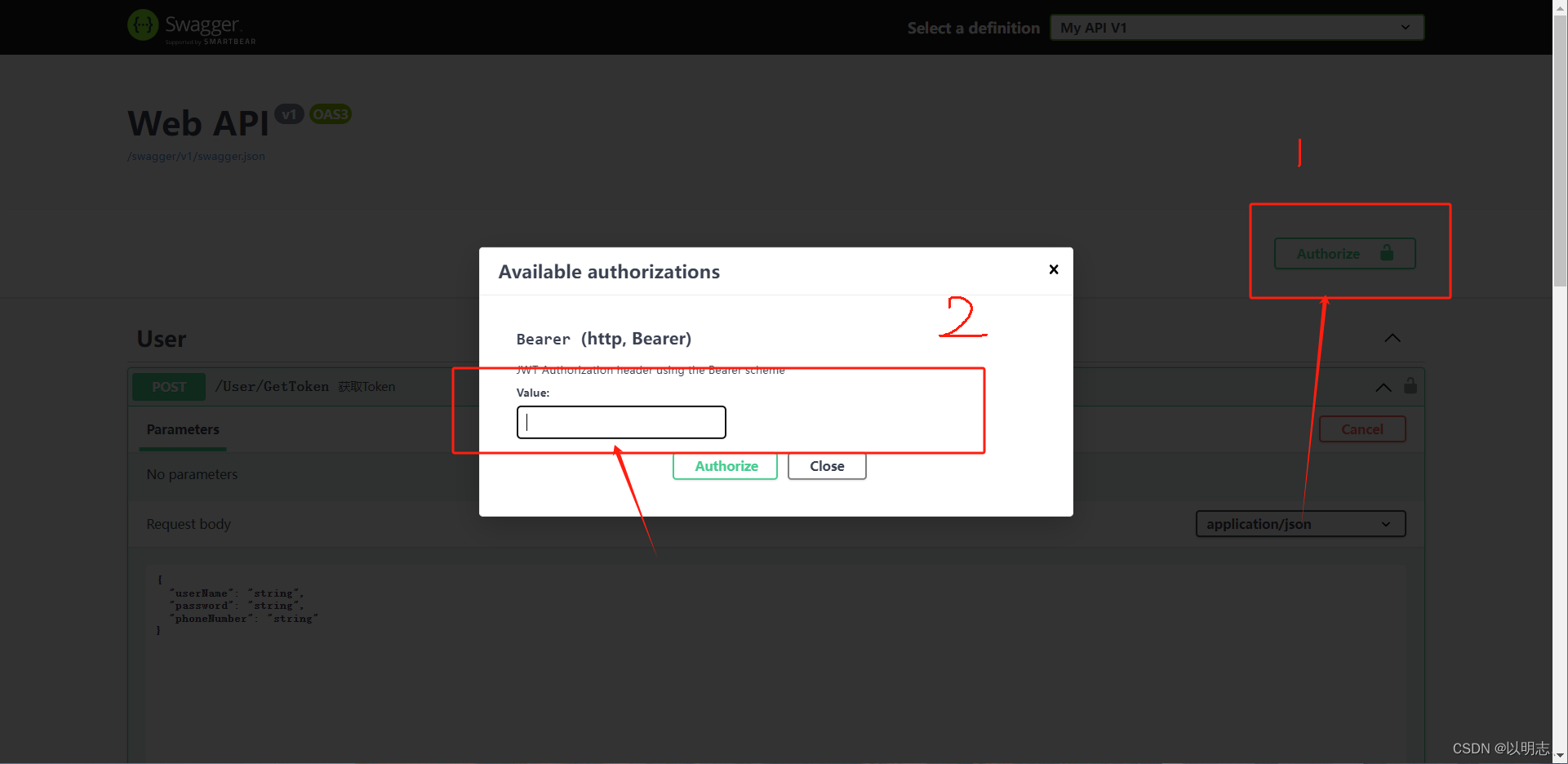
配置SqlSugar
0、引入SqlSugarCore包
1、编写Context类
public static SqlSugarClient db = new SqlSugarClient( new ConnectionConfig() { ConnectionString = "server = 127.0.0.1; Database = test; Uid = root; Pwd = root; AllowLoadLocalInfile = true;", DbType = DbType.MySql,//设置数据库类型 IsAutoCloseConnection = true,//自动释放数据务,如果存在事务,在事务结束后释放 });2、配置实体类
using SqlSugar; using System; using System.Collections.Generic; using System.Linq; using System.Text; using System.Threading.Tasks; namespace Blog.Core.Model.Models { [SugarTable(tableName: "Person")] public class User { [SugarColumn(IsPrimaryKey = true, IsIdentity = true)] public int Id { get; set; } public int Age { get; set; } public string? Name { get; set; } } }3、创建Service服务类进行数据库的CRUD
using Blog.core.IRepository; using Blog.Core.Model.Models; using static Blog.Core.Common.DbContext; namespace Blog.Core.Repository { public class UserRepository : IUserRepository { public int Add(User user) { var line = db.Insertable(user).ExecuteCommand(); return line; } public int Delete(int UserId) { var line = db.Deleteable(new User { Id = UserId }).ExecuteCommand(); return line; } public List GetUsers(int Id) { List users; if (Id is not 0) { users = db.Queryable().Where(it => it.Id == Id).ToList(); } else { users = db.Queryable().ToList(); } return users; } public int Update(User user) { var res = db.Updateable(user).ExecuteCommand(); return res; } } }4、配置Controller进行路由
using Blog.core.Models; using Blog.Core.Auth; using Blog.Core.IServices; using Blog.Core.Model.Models; using Microsoft.AspNetCore.Authorization; using Microsoft.AspNetCore.Mvc; using Blog.Core.Services; namespace Blog.core.Controllers { [Route("[controller]/[action]")] [ApiController] public class UserController : ControllerBase { private readonly IUserService _userService; public UserController( IUserService userService) { _userService = userService; } /// /// 增加 /// /// /// [HttpPost] public int AddUser(User user) { // User user = new User() { Id = 2024325, Name = "Czm", Age = 20 }; return _userService.Add(user); } /// /// 删除 /// /// /// [HttpDelete] public int DeleteUser(int id) { return _userService.Delete(id); } /// /// 更新 /// /// /// [HttpPut] public int UpdateUsre(User user) { return _userService.Update(user); } /// /// 获取数据 /// /// /// [HttpGet] public List GetUser(int id) { return _userService.GetUsers(id); } } }依赖注入与IOC
IOC
IOC 是 Inversion of Control(控制反转)的缩写。在软件开发中,IOC 是一种设计模式,它改变了传统的程序设计流程,使得对象之间的依赖关系由代码本身控制变为由外部容器控制。
而采用IOC 设计模式后,对象之间的依赖关系由外部容器来管理和注入,对象本身不需要关心依赖的具体实现,只需要定义自己的接口或抽象类,并在外部容器中配置依赖关系。这样可以降低代码的耦合度,提高代码的灵活性、可维护性和可扩展性。
常见的IOC 容器包括 Spring Framework 中的 Spring IoC ,dotnet中的autofoc,它通过依赖注入(Dependency Injection)的方式来实现控制反转。通过IOC 容器,可以将对象之间的依赖关系集中管理,实现了代码的松耦合,使得程序更易于理解、扩展和维护。
依赖注入DI
1、继承接口并实现构造方法
public class UserService : IUserService { private IUserRepository _userService ; public UserService(IUserRepository userService) { _userService = userService; } }2、在program里加上
builder.Services.AddTransient(); builder.Services.AddTransient();
.net提供了三种生命周期的容器
builder.Services.AddTransient(); builder.Services.AddScoped(); builder.Services.AddSingleton();
- 暂时性对象始终不同。 IndexModel 和中间件中的临时 OperationId 值不同。
- 范围内对象对给定请求而言是相同的,但在每个新请求之间不同。
- 单一实例对象对于每个请求是相同的。
3、Controller层使用
public class UserController : ControllerBase { private readonly IUserService _userService ; public UserController(IUserService userService) { _userService = userService; } }Autofac轻量容器的使用
1、安装Nuget包Autofac.Extensions.DependencyInjection和Autofac.Extras.DynamicProxy
2、使用程序集注册,通过Model注册(这里只列这一种Auto官方文档Assembly Scanning — Autofac 7.0.0 documentation)
**创建Model类 **
using Autofac; using Blog.Core.IServices; using Microsoft.AspNetCore.Mvc; using Microsoft.Extensions.DependencyModel; using System.Reflection; using System.Runtime.Loader; namespace Blog.Core.Configuration.AutoModule { public class ServiceModel: Autofac.Module { protected override void Load(ContainerBuilder builder) { // 自动对集成 IDependency 接口的类进行注册 Type baseType = typeof(IUserService); var compilationLibrary = DependencyContext.Default.CompileLibraries.Where(x => !x.Serviceable && x.Type == "project").ToList(); List assemblyList = new List(); foreach (var _compilation in compilationLibrary) { try { assemblyList.Add(AssemblyLoadContext.Default.LoadFromAssemblyName(new AssemblyName(_compilation.Name))); } catch (Exception ex) { Console.WriteLine(_compilation.Name + ex.Message); } } builder.RegisterAssemblyTypes(assemblyList.ToArray()).Where(type => baseType.IsAssignableFrom(type) && !type.IsAbstract) .AsSelf() .AsImplementedInterfaces() .PropertiesAutowired() .InstancePerLifetimeScope(); var controllersTypesInAssembly = typeof(Program).Assembly.GetExportedTypes() .Where(type => typeof(ControllerBase).IsAssignableFrom(type)).ToArray(); builder.RegisterTypes(controllersTypesInAssembly).PropertiesAutowired(); } } }**在program.cs中解析Model **
builder.Host.UseServiceProviderFactory(new AutofacServiceProviderFactory()); builder.Host.ConfigureContainer(i => i.RegisterModule()); builder.Services.AddControllers().AddControllersAsServices();
在Controller中使用
public class UserController : ControllerBase { private readonly IUserService _userService ; public UserController(IUserService userService) { _userService = userService; } }使用Autofac完成AOP日志
1、编写AOP类
using Castle.DynamicProxy; using Newtonsoft.Json; using StackExchange.Profiling; using System.Reflection; namespace Blog.Core.AOP { /// /// 拦截器BlogLogAOP 继承IInterceptor接口 /// public class BlogLogAOP : IInterceptor { /// /// 实例化IInterceptor唯一方法 /// /// 包含被拦截方法的信息 public void Intercept(IInvocation invocation) { string UserName = "Jamin"; //记录被拦截方法信息的日志信息 var dataIntercept = "" + $"【当前操作用户】:{UserName} \r\n" + $"【当前执行方法】:{invocation.Method.Name} \r\n" + $"【携带的参数有】: {string.Join(", ", invocation.Arguments.Select(a => (a ?? "").ToString()).ToArray())} \r\n"; try { MiniProfiler.Current.Step($"执行Service方法:{invocation.Method.Name}() -> "); //在被拦截的方法执行完毕后 继续执行当前方法,注意是被拦截的是异步的 invocation.Proceed(); // 异步获取异常,先执行 if (IsAsyncMethod(invocation.Method)) { //Wait task execution and modify return value if (invocation.Method.ReturnType == typeof(Task)) { invocation.ReturnValue = InternalAsyncHelper.AwaitTaskWithPostActionAndFinally( (Task)invocation.ReturnValue, ex => { LogEx(ex, ref dataIntercept); }); } else //Task { invocation.ReturnValue = InternalAsyncHelper.CallAwaitTaskWithPostActionAndFinallyAndGetResult( invocation.Method.ReturnType.GenericTypeArguments[0], invocation.ReturnValue, ex => { LogEx(ex, ref dataIntercept); }); } } else {// 同步1 } } catch (Exception ex)// 同步2 { LogEx(ex, ref dataIntercept); } var type = invocation.Method.ReturnType; if (typeof(Task).IsAssignableFrom(type)) { var resultProperty = type.GetProperty("Result"); dataIntercept += ($"【执行完成结果】:{JsonConvert.SerializeObject(resultProperty.GetValue(invocation.ReturnValue))}"); } else { dataIntercept += ($"【执行完成结果】:{invocation.ReturnValue}"); } // 你的日志记录 比如log4 #region 输出到当前项目日志 var path = Directory.GetCurrentDirectory() + @"\Log"; if (!Directory.Exists(path)) { Directory.CreateDirectory(path); } string fileName = path + $@"\InterceptLog-{DateTime.Now.ToString("yyyyMMddHHmmss")}.log"; StreamWriter sw = File.AppendText(fileName); sw.WriteLine(dataIntercept); sw.Close(); #endregion } private void LogEx(Exception ex, ref string dataIntercept) { if (ex != null) { //执行的 service 中,收录异常 MiniProfiler.Current.CustomTiming("Errors:", ex.Message); //执行的 service 中,捕获异常 dataIntercept += ($"方法执行中出现异常:{ex.Message + ex.InnerException}\r\n"); } } public static bool IsAsyncMethod(MethodInfo method) { return ( method.ReturnType == typeof(Task) || (method.ReturnType.IsGenericType && method.ReturnType.GetGenericTypeDefinition() == typeof(Task)) ); } } internal static class InternalAsyncHelper { public static async Task AwaitTaskWithPostActionAndFinally(Task actualReturnValue, Action finalAction) { Exception exception = null; try { await actualReturnValue; } catch (Exception ex) { exception = ex; } finally { finalAction(exception); } } public static async Task AwaitTaskWithPostActionAndFinallyAndGetResult(Task actualReturnValue, Func postAction, Action finalAction) { Exception exception = null; try { var result = await actualReturnValue; await postAction(); return result; } catch (Exception ex) { exception = ex; throw; } finally { finalAction(exception); } } public static object CallAwaitTaskWithPostActionAndFinallyAndGetResult(Type taskReturnType, object actualReturnValue, Action finalAction) { return typeof(InternalAsyncHelper) .GetMethod("AwaitTaskWithPostActionAndFinallyAndGetResult", BindingFlags.Public | BindingFlags.Static) .MakeGenericMethod(taskReturnType) .Invoke(null, [actualReturnValue, finalAction]); } } }2、进行服务注册
builder.Host.UseServiceProviderFactory(new AutofacServiceProviderFactory()); builder.Host.ConfigureContainer(build => { // AOP var cacheType = new List(); build.RegisterType(); cacheType.Add(typeof(BlogLogAOP)); // 获取 Service.dll 程序集服务,并注册 var assemblysServices = Assembly.LoadFrom(servicesDllFile); build.RegisterAssemblyTypes(assemblysServices) .AsImplementedInterfaces() .InstancePerDependency() .EnableInterfaceInterceptors()//引用Autofac.Extras.DynamicProxy; .InterceptedBy(cacheType.ToArray());//允许将拦截器服务的列表分配给注册。 // 获取 Repository.dll 程序集服务,并注册 var assemblysRepository = Assembly.LoadFrom(repositoryDllFile); build.RegisterAssemblyTypes(assemblysRepository) .AsImplementedInterfaces() .InstancePerDependency(); });Webapi的操作返回值和方法参数
返回值ActionResult
ASP.NET Core Web API中的操作方法的返回值如果是普通数据类型,那么返回值就会默认被序列化为JSON格式的响应报文体返回。
1 [HttpGet("{id}")] 2 public ActionResult GetPerson(int id) 3 { 4 if (id user } from "@/store/Store"; const requestUrl = "http://localhost:5250"; const userStore = user(); //创建实例 const axiosInstance = axios.create({ baseURL: requestUrl, // timeout: 3000, }); //请求拦截器,请求前 axiosInstance.interceptors.request.use( (config) = { if (userStore.data) { // console.log("请求头toekn=====>", userStore.data.token); // 设置请求头 // config.headers['token'] = useToken.token; config.headers.Authorization = `Bearer ${userStore.data.token}`; } return config; }, (error) => { return Promise.reject(error); } ); //请求拦截器,请求后 axiosInstance.interceptors.response.use( (response) => { if (response.status === 200) return response.data; }, (error) => { console.log(error); const status: number = error.response.status; switch (status) { case 404: console.error("资源不存在"); break; case 401: console.error("没有权限"); break; case 500: case 501: case 502: console.error("没有权限"); break; case 400: console.error(error.response.data.msg + "参数错误"); break; default: console.log("无法识别"); break; } return Promise.reject(error); } ); interface ActionResult { data: T; msg: string; error: any; code: number; } //get请求 export const get = ( url: string, params?: Object ): Promise => { return axiosInstance.get(url, { params }); }; //post请求 export const post = ( url: string, data?: Object ): Promise => { return axiosInstance.post(url, data); }; //put请求 export const put = ( url: string, data?: Object ): Promise => { return axiosInstance.put(url, data); }; //delete请求 export const delete1 = ( url: string, params?: Object ): Promise => { return axiosInstance.delete(url, { params }); };封装api接口调用方法
import { get, post, delete1, put } from "./request"; import { user } from "@/types/index"; export const loginApi = (data: user) => { return post("/api/Login/login", data); }; export const getUserInfo = (ID: string) => { return get("/api/Index/UserInfo", { ID }); };在页面中调用api
import { loginApi } from "@/common/api"; const emailLoginApi = async () => { phoneLoding.value = true; try { const res = await loginApi({ EMAIL: emailNumber.value, PASSWORD: PassWard.value, }); // localStorage.setItem("userInfo", JSON.stringify(res.data.token)); // Cookies.set("token", res.data.token); console.log(res); userStore.setData(res.data); console.log(userStore.data); $router.push("/index"); phoneLoding.value = false; } catch (error) { phoneLoding.value = false; } };pinia使用
使用npm下载pinia
npm i pinia
创建Store文件进行状态存储
import { defineStore } from "pinia"; export const user = defineStore("userInfo", { state: () => ({ data: { id: "", Name: "", token: "", Email: "" }, }), actions: { setData(payload: any) { this.data = payload; }, }, });在页面组件中实例化状态并赋值
import { user } from "@/store/Store"; const userStore = user(); // 实例化 store userStore.setData(res.data);






还没有评论,来说两句吧...